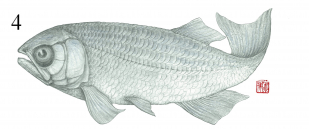 HKU Department of Earth Science
HKU Department of Earth Science
News
Department of Earth Sciences graduate publishes research on HK's first identified dinosaur-era vertebrate
Life and Planetary Evolution | March 31, 2015
Mr. Edison Tse Tze-kei, graduate of the Class of 2014, Department of Earth Sciences has recently published a paper in the open-access journal PeerJ identifying an ~147 million-year-old Jurassic-aged osteoglossoid osteoglossomorph fish Paralycoptera from outcrops at Lai Chi Chong, Hong Kong. This fossil represents the first dinosaur-era fish – as well as vertebrate – from Hong Kong to be identified. Edison's research was completed as part of his Faculty of Science Summer Research Fellowship and Earth Sciences Major final-year project which were supervised by Dr. Michael Pittman of the Department's Vertebrate Palaeontology Laboratory (Life and Planetary Evolution Research Group). Edison and Michael collaborated with world-renown fossil fish expert Professor Chang Mee-mann, an Academician of the Chinese Academy of Sciences from the Institute of Vertebrate Paleontology and Paleoanthropology (IVPP) in Beijing. Prof. Chang erected the genus Paralycoptera in 1977 and helped to ensure that Edison and Dr. Pittman's identification was robust. The HK specimen belongs to the collections of the Stephen Hui Geological Museum and extends the temporal and geographical range of Paralycoptera by approximately 40 million years back in time and by around 700km further south, providing an opportunity to reevaluate current understanding of Chinese Mesozoic fish faunas and of osteoglossomorphan fish evolution more generally. Edison's publication demonstrates international recognition of the outstanding ability of departmental undergraduate students in conducting scientific research, and highlights the research opportunities that the Department of Earth Sciences provides to its undergraduate students.
Congratulations Edison and Dr. Pittman!
For further details please see the HKU press release.
Figure 1: Hong Kong’s first dinosaur-era fish -
a specimen of the Chinese osteoglossoid osteoglossomorph fish Paralycoptera (Image courtesy of IVPP).
Figure 2: Line drawing showing the
specimen’s tail anatomy.
Abbreviations: ep, epural;
h1-6, hypurals 1-6;
hsp2-5, haemal spines on preural centrum 2-5;
nsp1-5, neural spines on preural centrum 1-5;
nspu1, neural spine on u1;
ph, parhypural; pr.r, procurrent rays;
pu1, preural 1;
u1, u2, ural centra 1 and 2;
un, uroneurals;
(Image courtesy of Tse et al. 2015).
Figure 3: Reconstruction of the skeleton of Paralycoptera
(Image courtesy of Prof. Chang Mee-Mann, IVPP).




